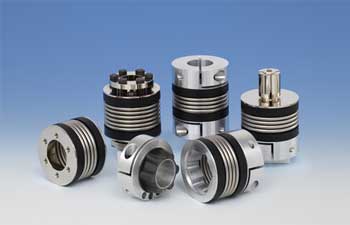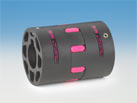 Flexible and rigid Shaft
and Servo Couplings
Flexible and rigid Shaft
and Servo Couplings
THE BASICS OF FLEXIBLE SERVO COUPLINGS
courtesy of R+W America

In any direct mechanical drive system there exists a need to couple the variety of driven elements that may be included. The majority of drive elements, including gear reducers, lead screws, and a host of other components, are driven by shafting that is supported by multiple bearings. This allows for shafting to be held extremely straight and rigid while rotating, avoiding any possible balancing and support problems. The result of this rigid support is the virtual impossibility of avoiding slight misalignments between a driving and driven shaft when they are connected. Restoring forces that occur as the two coupled shafts compete to maintain their original positions can put unwanted strain on shaft bearings, causing them to wear out prematurely. Additional axial loads are also placed on the bearings as thermal growth occurs in shafting during operation.
Flexible element absorb lateral, angular, and axial restoring forces
The simple and most commonly employed solution to the problem of shaft misalignment is the use of a flexible element to absorb lateral, angular, and axial restoring forces, while maintaining some amount of rigidity in rotation. The degree to which this torsional rigidity is required varies from one application to another. A broad range of coupling designs are currently employed to provide the necessary flexibility, and can be broken down into two major categories: torsionally flexible couplings and zero backlash couplings.
In applications where the timing and accuracy of a drive system are not critical, a regular jaw type coupling is most commonly used. These couplings normally consist of two sets of interlocking teeth, each set mounting to its respective shaft end via a keyway. A gap exists between each alternating jaw, and a flexible rubber or plastic insert, often called a spider, is placed in between the coupling halves. These torsionally flexible couplings introduce backlash into a drive system, causing a delay between rotation of the driving shaft and the driven shaft.
Other drive systems require a quick and immediate response from driven elements when the motor begins rotation. One good example of such a necessity is in a servo drive, where starts, stops, and load reversals are precisely monitored by a computer controller. Couplings need to maintain their flexibility across three axes of misalignment, while transmitting rotational power as precisely as possible. Not only is the fact that they operate with zero backlash critical, but they must also rotate with minimal wind-up, which is the twisting action exhibited by couplings that are not very torsionally stiff.
A flexible coupling with bellows is ideal
The ideal flexible coupling for this application is a bellows type. These couplings normally consist of two radial clamping hubs attached to the ends of a metal bellows, which looks something like a round accordion. Higher quality couplings use a stainless steel bellow, since it is the most torsionally rigid type of the materials that are readily available. The corrugations formed into the stainless steel tube allow the coupling to be flexible across the three axes of shaft misalignment, while limiting wind-up to its lowest possible value, resulting in the highest accuracy possible. More information on this type is available at R+W America.
While most mechanical drive systems most appropriately require one of the two styles described above, there lies a variety of other designs between these two grades, each with different levels of applicability in different areas. Some of the more commonly found include: disk, beam, helical, grid and oldham couplings. These couplings are available from a number of different manufacturers, each of which designed them with specific applications in mind.
When designing and assembling a direct mechanical drive system, the use of
flexible couplings between shafts will protect machinery from premature wear
and breakdown. They can play a key role in dramatically extending the service
life of the drive elements they connect. With proper selection of the right
flexible coupling for any application, ideal linkage can be achieved for any
motion system.

